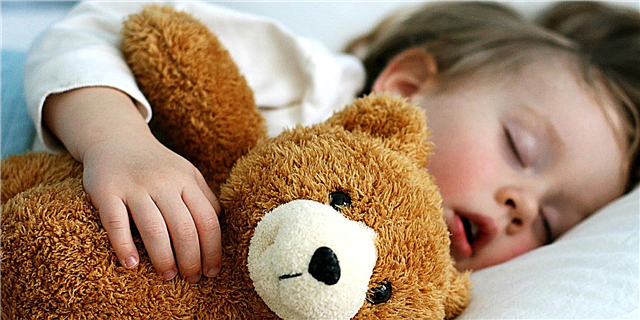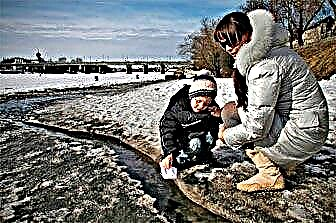At the eighth month, the baby continues to develop dynamically in different directions: physically, emotionally, socially. At this age, the foundation is created for the future development of the senses, motor skills, sensory apparatus and speech skills.

Nevertheless, the level of development of a child at 8 months can be different: someone will surprise their parents with the first word, and someone continues to pronounce only individual sounds, some mothers are already pleased with babies with a smile with four teeth, and some have not yet one. The first months of the second half of the year are the time of prerequisites and beginnings.
Physical development
The growth rate of the child decreases slightly (since physical activity increases), in the eighth month the baby gains about 500 - 600 g and grows by 1.5 - 2 cm. By the end of the month, children gain weight up to 8 - 9 kg (± 1 kg) and height 67 - 71 cm (± 3 cm).

At 8 months, a child can already have 4 teeth: two lower and two upper central incisors. But if the crumbs do not yet have teeth, then this is also normal and should not worry the parents (about teething).
What have you learned
- A child from a lying position knows how to sit down on his own, and also lie back from a sitting position.
- All children know how to roll over in different directions (we teach to roll over).
- Can stand, holding on to the railing of the crib and move sideways, making small side steps. If you take a child's hand, then he tries to walk.
- The kid can play "okay", wave a pen.
- Some children can crawl well (how to teach a child to crawl). They can also crawl while holding an object in one hand.
- Can grip small objects with two fingers.
- Perform various actions with toys: roll a ball, string rings, swing a doll.
- Can recognize himself in photographs and in a mirror.
- Points to the object being spoken about.
- Can drink from a cup, eat small pieces of food. "Treats" mom.
- Knows how to pull off a sock from his feet.
- Do not resist when planting on a pot.
- To recognize mom, dad, another close person among adults.
Psychological development
- Your child is getting better at understanding your speech. He can even fulfill some requests: give me a ball, take a cube.
- The affection for the mother becomes even stronger. Parting is more difficult, he is calm only next to his mother. But he makes contact faster if a stranger is friendly to the baby.
- The perception of loud sounds (vacuum cleaner, hairdryer) is sharpened. Many babies at this age are afraid of these devices (what to do if the child is afraid of loud noises).
- The child not only grabs, touches and probes new objects, but also strokes them with his finger or palm.
- The kid asks by gestures to bring him to an object that is of interest to him. He reaches for the window, the refrigerator, the cupboards and tries to open them.
- Smiling at her reflection in the mirror.
- Understands the prohibition, takes offense when they talk to him strictly.
- The child's eyes get used to seeing objects from different angles. The kid recognizes familiar things at a distance in any position: in profile, upside down. Now the baby is clearly aware of the quality of things: color, texture, softness, shape and is able to manipulate objects, taking into account their properties: roll a ball, tear a piece of paper, pull a string.
- The kid can do something on his own for more than 10 minutes. Moreover, if the child is distracted from the lesson, then after a short pause, he can remember his game and continue it.
- It becomes important for a child to learn and achieve something, so the baby already reacts to good luck and failure with joy or grief. It is very important now to praise the baby and support him in his endeavors.
- May show first attempts to manipulate you. Do not follow the lead, let the kid understand what is not allowed and what is allowed.
- Seeks emotional contact with other children: looks at another child, smiles at him and can reach out to touch.
We read in detail: what a child can do at 8 months
Baby development test at 8 months
- When the child is lying, show him the toy from a distance, let him reach for it. The kid should be able to sit up without your help;
- In a sitting position, the baby should be able to take off the diaper that you covered him with;
- Hold the toy out to your child and when he grabs it, try to take it away. At 8 months, the child should show a resistance reaction: take away, pull towards himself, push away your hand if he protests;
- Playing hide and seek, the baby laughs at your appearance;
- Recognizes familiar faces in the photograph, can name them: "pa", "ma";
- Place a small object on the table. The kid should be able to take it with two fingers;
- A child at 8 months begins to copy your actions: show how to roll a ball on the floor, he will try to repeat it;
- Name 2 - 3 objects that the child knows about. The baby must find them with a glance or show them with a finger.
What should be alarming
- The child does not sit down, does not try to get up, does not turn over, does not try to crawl;
- Cannot stand at support or support;
- The suggested toy is missing. Does not transfer a toy from one handle to another;
- Doesn't babble. Doesn't pronounce syllables;
- Shows no emotion.
Mom Lara: Baby at 8 months. Baby development
Lure
The baby's nutrition at 8 months remains five times a day. Already two breastfeeds must be replaced. The first and last feedings (after sleep and before bedtime) should remain breastfeeding. Intervals between feedings 4 - 4.5 hours.
Now you can make multi-component cereals and purees, that is, consisting of several vegetables, fruits and cereals. At the beginning of the eighth month, you can diversify the complementary foods with vegetable puree from potatoes in combination with other vegetables (zucchini, carrots, pumpkin, cauliflower) and start giving wheat bread 5 g. By the end of the month, fermented milk products are introduced: cottage cheese and kefir, with good tolerance, gradually replacing one more feeding. In general, the eighth month is spent on the introduction of yet unfamiliar vegetables, fruits and cereals, and their assimilation in the complex. Thus, if you started introducing complementary foods at 6 months, then by the end of the 8th month you should have changed three breastfeeds.
How to help your baby develop
- Continue to carry the baby in your arms. Holding (carrying) remains an important element in the psychological development of the child.
- Enrich the vocabulary of the crumbs by reading books to him, talking about the world around him. Talk to your child in an affectionate tone, call him by name. Draw your baby's attention to everything new. Scientists argue that the number of words a child hears during the day directly affects the intellectual level in the future. The more you communicate with the baby, the wider his potential when he grows up.
Do not make fun of the child, do not distort the words, talk to the baby as with a person who understands everything that you say. Even if the child pronounces something wrong, uses the first syllable of the word, then you still speak the way you need to. Tell your baby that you love him more often.
Ensure safety in the house, since the child is now interested in everything and pulls into his mouth: remove medicines and chemicals in places inaccessible to the child, install plugs in sockets, buy nozzles for furniture corners, remove all cords and wires from the floor, move out of the way child all unstable objects, place the plants higher.
Useful toys for a baby 8 months
- Rubber balls: strengthen the ball at the baby's feet in the crib, he will be happy to kick it;
- Squeaky hammer: Show your toddler how to knock on the table. By cubes. This activity will develop coordination and strengthen the muscles of the arms;
- Continue to give your child bags or pads filled with fillers (peas, beans, beads) to help develop fine motor skills;
- Musical toys: All kids love toys with buttons that play music or sounds when pressed. Such toys develop well logical thinking, as well as motor skills and intelligence;
- Soft textile or cardboard books: the crumb can already turn the pages by itself;
- Bath games: teach your child how to move toys in the water, clap the water with your palm, draw water into a mold, pour from one jar to another.

Activities with a child at 8 months
- "Orchestra": wooden spoons or drum sticks, maracas are suitable for playing. Place pots, boxes, bowls in front of the baby and show how to hit them;
- "Repeats": first the child repeats after you, you wave your hand and he waves, you laugh and clap your hands, then he. After that, you repeat after the child;
- Build a pyramid out of cubes and show the kid how to throw the ball to make the pyramid fall apart;
- Show your child kitchen utensils: containers, spoons, ladles, in general, everything that is safe. Young children love to play with adult objects;
- By the age of nine months, you can start rolling the ball to each other on the floor.
While bathing, gradually draw water into the bath when the baby is already there, lying on his tummy. When the water is filled up, the child will rise and begin to get up on all fours. Make sure that the crumb does not spill water.
"Hand-walk": take the child by the legs, lift and begin to gently rock back and forth. The crumb will start to rest with the handles and touch them.
Arrange for the child a "carousel" in his arms, swing in different directions in a vertical and horizontal position. Swing with him on the swing. It develops the vestibular apparatus well.
A sense of balance is well developed by walkers, they can already be used. But remember that you can keep a child in them no more than 1 hour a day and no more than 15 minutes in a row, as this can negatively affect the spine and gait. (About walkers - PROS and CONS)
Walk with your child for at least 2 hours a day. At home, continue to do daily gymnastics, air baths and massage.
When choosing activities for your child, consider their preferences and temperament. At this age, children already have personality traits. If your baby is restless, then provide him with active games with crawling, turning and other movements. Calm children will rather enjoy looking at a book, listening to a fairy tale, or building a pyramid from cubes. Respect the interests of your child, do not force him to do something if you feel that the child does not like it, it does not work out and he is drawn to something completely different.
Sleep and wakefulness remains the same as in previous months: at night, children sleep up to 10 hours, some even without waking up. Two naps of 1.5 - 2 hours remain during the day.
← 7 month of development 9 month of development →



